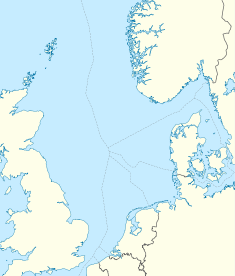- Oseberg South
-
Oseberg South Location of Oseberg South Country Norway Location North Sea Block(s) 30/6, 30/9 Offshore/onshore offshore Coordinates 60°23′24.62″N 2°47′49.06″E / 60.3901722°N 2.7969611°ECoordinates: 60°23′24.62″N 2°47′49.06″E / 60.3901722°N 2.7969611°E Operator(s) Statoil Partners Statoil (49.3%)
Petoro (33.6%)
Total S.A. (10%)
ExxonMobil (4.7%)
ConocoPhillips (2.4%)Field history Discovery 1984 Start of production 2000 Production Recoverable oil 346 million barrels (~4.72×107 t) Recoverable gas (billion cubic meters) 16 Producing formations Jurassic sandstones Oseberg South (Norwegian: Oseberg Sør) is an offshore oil field in the North Sea, located 115 kilometres (71 mi) from the coastline and 13 kilometres (8.1 mi) south of Oseberg Oil Field. Oseberg Sør was discovered in 1984.[1] The field was developed with a fixed production, drilling and quarters (PDQ) facility and is operated by Statoil. The first stage phase processing is done at the Oseberg Øst platform. The second and third phase processing of oil is done at the Oseberg Field Center and it is then transported to Sture terminal in Norway through the Oseberg Transport System. The development of the Oseberg Sør was approved in 1977. Recent updates include approval of J structure[2] which started producing in November 2006 and Oseberg Sør G Sentral which has been developed in 2009.[3]
Contents
Technical features
The sea depth at location is 100 m (330 ft). The platform at Oseberg Sør which was built for drilling of 30 wells[4] includes a 125-metre (410 ft) tall steel jacket which supports a total topside dry weight of nearly 14,000 tonnes. It also includes a 100 bed capacity living quarters, first stage processing facilities, power generation and utility systems and a high performance drilling package. The field produces up to 14,900 cubic metres (530,000 cu ft) of oil, 3.4 million cubic metres (120×106 cu ft) of natural gas and 12,800 cubic metres (450,000 cu ft) of water per day[5] The field consists of ten accumulations within Jurassic sandstones, all in separate structures. The reservoirs lie at a depth of 2,200–2,800 metres (7,200–9,200 ft). Production lifetime is estimated at 20 years.[3][6] It is believed to contain a total of 346 million barrels (55.0×106 m3) of recoverable oil and up to 16 billion cubic metres (570×109 cu ft) of recoverable gas.[4]
See also
- Oseberg Oil Field
- Oseberg Øst
- Sture terminal
- Oseberg Transport System
- Grane oil field
- Grane oil pipeline
- North Sea oil
References
- ^ Offshore Technology. Oseberg Sør, North Sea Northern, Norway
- ^ "Drilling of 2 Production Wells to Commence at Oseberg Sor J Structure". Rigzone. 5 December 2008. https://www.rigzone.com/news/article.asp?a_id=70386. Retrieved 16 December 2009.
- ^ a b OLJEDIREKTORATET Norwegian Petroleum Directorate
- ^ a b "Oseberg Sør officially opens" (Press release). Norsk Hydro. 1 March 2001. http://www.hydro.com/en/Press-room/News/Historic-news-archive/2001/March/Oseberg-Sor-officially-opens/. Retrieved 16 December 2009.
- ^ Dr Friedrich Schneider (September–October 1999). "Automation central to Oseberg Sør rig". Drilling Contractor. http://www.iadc.org/dcpi/dc-sepoct99/s-oseberg.pdf. Retrieved 16 December 2009.
- ^ Termotite data on Oseberg Sør Project
External links
- Picture of installation of topsides at Oseberg Sør
- Statoil website
- Map of Oseberg field from OLJEDIREKTORATET Norwegian Petroleum Directorate
Resources in Norway Resources: Oil:Natural gas: Categories:
Categories:- Oil fields in Norway
- North Sea energy
- Energy in Europe
- Energy in Norway
Wikimedia Foundation. 2010.

